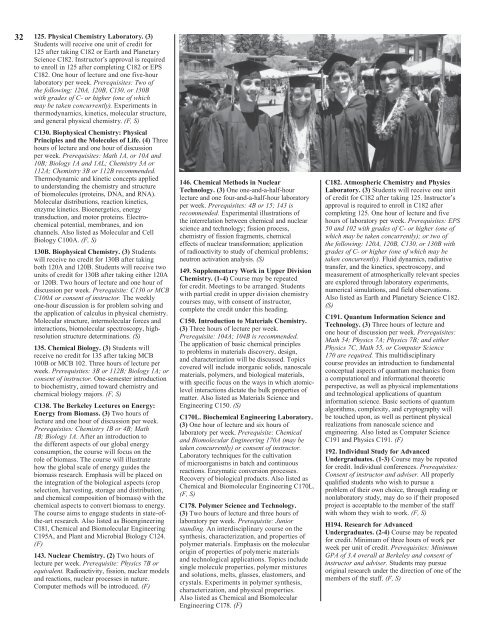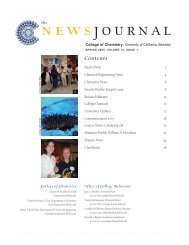12-13 Coc Guide v7 - College of Chemistry - University of ...
12-13 Coc Guide v7 - College of Chemistry - University of ...
12-13 Coc Guide v7 - College of Chemistry - University of ...
You also want an ePaper? Increase the reach of your titles
YUMPU automatically turns print PDFs into web optimized ePapers that Google loves.
32<br />
<strong>12</strong>5. Physical <strong>Chemistry</strong> Laboratory. (3)<br />
Students will receive one unit <strong>of</strong> credit for<br />
<strong>12</strong>5 after taking C182 or Earth and Planetary<br />
Science C182. Instructor’s approval is required<br />
to enroll in <strong>12</strong>5 after completing C182 or EPS<br />
C182. One hour <strong>of</strong> lecture and one five-hour<br />
laboratory per week. Prerequisites: Two <strong>of</strong><br />
the following: <strong>12</strong>0A, <strong>12</strong>0B, C<strong>13</strong>0, or <strong>13</strong>0B<br />
with grades <strong>of</strong> C- or higher (one <strong>of</strong> which<br />
may be taken concurrently). Experiments in<br />
thermodynamics, kinetics, molecular structure,<br />
and general physical chemistry. (F, S)<br />
C<strong>13</strong>0. Biophysical <strong>Chemistry</strong>: Physical<br />
Principles and the Molecules <strong>of</strong> Life. (4) Three<br />
hours <strong>of</strong> lecture and one hour <strong>of</strong> discussion<br />
per week. Prerequisites: Math 1A, or 10A and<br />
10B; Biology 1A and 1AL; <strong>Chemistry</strong> 3A or<br />
1<strong>12</strong>A; <strong>Chemistry</strong> 3B or 1<strong>12</strong>B recommended.<br />
Thermodynamic and kinetic concepts applied<br />
to understanding the chemistry and structure<br />
<strong>of</strong> biomolecules (proteins, DNA, and RNA).<br />
Molecular distributions, reaction kinetics,<br />
enzyme kinetics. Bioenergetics, energy<br />
transduction, and motor proteins. Electrochemical<br />
potential, membranes, and ion<br />
channels. Also listed as Molecular and Cell<br />
Biology C100A. (F, S)<br />
<strong>13</strong>0B. Biophysical <strong>Chemistry</strong>. (3) Students<br />
will receive no credit for <strong>13</strong>0B after taking<br />
both <strong>12</strong>0A and <strong>12</strong>0B. Students will receive two<br />
units <strong>of</strong> credit for <strong>13</strong>0B after taking either <strong>12</strong>0A<br />
or <strong>12</strong>0B. Two hours <strong>of</strong> lecture and one hour <strong>of</strong><br />
discussion per week. Prerequisite: C<strong>13</strong>0 or MCB<br />
C100A or consent <strong>of</strong> instructor. The weekly<br />
one-hour discussion is for problem solving and<br />
the application <strong>of</strong> calculus in physical chemistry.<br />
Molecular structure, intermolecular forces and<br />
interactions, biomolecular spectroscopy, highresolution<br />
structure determinations. (S)<br />
<strong>13</strong>5. Chemical Biology. (3) Students will<br />
receive no credit for <strong>13</strong>5 after taking MCB<br />
100B or MCB 102. Three hours <strong>of</strong> lecture per<br />
week. Prerequisites: 3B or 1<strong>12</strong>B; Biology 1A; or<br />
consent <strong>of</strong> instructor. One-semester introduction<br />
to biochemistry, aimed toward chemistry and<br />
chemical biology majors. (F, S)<br />
C<strong>13</strong>8. The Berkeley Lectures on Energy:<br />
Energy from Biomass. (3) Two hours <strong>of</strong><br />
lecture and one hour <strong>of</strong> discussion per week.<br />
Prerequisites: <strong>Chemistry</strong> 1B or 4B; Math<br />
1B; Biology 1A. After an introduction to<br />
the different aspects <strong>of</strong> our global energy<br />
consumption, the course will focus on the<br />
role <strong>of</strong> biomass. The course will illustrate<br />
how the global scale <strong>of</strong> energy guides the<br />
biomass research. Emphasis will be placed on<br />
the integration <strong>of</strong> the biological aspects (crop<br />
selection, harvesting, storage and distribution,<br />
and chemical composition <strong>of</strong> biomass) with the<br />
chemical aspects to convert biomass to energy.<br />
The course aims to engage students in state-<strong>of</strong>the-art<br />
research. Also listed as Bioengineering<br />
C181, Chemical and Biomolecular Engineering<br />
C195A, and Plant and Microbial Biology C<strong>12</strong>4.<br />
(F)<br />
143. Nuclear <strong>Chemistry</strong>. (2) Two hours <strong>of</strong><br />
lecture per week. Prerequisite: Physics 7B or<br />
equivalent. Radioactivity, fission, nuclear models<br />
and reactions, nuclear processes in nature.<br />
Computer methods will be introduced. (F)<br />
146. Chemical Methods in Nuclear<br />
Technology. (3) One one-and-a-half-hour<br />
lecture and one four-and-a-half-hour laboratory<br />
per week. Prerequisites: 4B or 15; 143 is<br />
recommended. Experimental illustrations <strong>of</strong><br />
the interrelation between chemical and nuclear<br />
science and technology; fission process,<br />
chemistry <strong>of</strong> fission fragments, chemical<br />
effects <strong>of</strong> nuclear transformation; application<br />
<strong>of</strong> radioactivity to study <strong>of</strong> chemical problems;<br />
neutron activation analysis. (S)<br />
149. Supplementary Work in Upper Division<br />
<strong>Chemistry</strong>. (1-4) Course may be repeated<br />
for credit. Meetings to be arranged. Students<br />
with partial credit in upper division chemistry<br />
courses may, with consent <strong>of</strong> instructor,<br />
complete the credit under this heading.<br />
C150. Introduction to Materials <strong>Chemistry</strong>.<br />
(3) Three hours <strong>of</strong> lecture per week.<br />
Prerequisite: 104A; 104B is recommended.<br />
The application <strong>of</strong> basic chemical principles<br />
to problems in materials discovery, design,<br />
and characterization will be discussed. Topics<br />
covered will include inorganic solids, nanoscale<br />
materials, polymers, and biological materials,<br />
with specific focus on the ways in which atomiclevel<br />
interactions dictate the bulk properties <strong>of</strong><br />
matter. Also listed as Materials Science and<br />
Engineering C150. (S)<br />
C170L. Biochemical Engineering Laboratory.<br />
(3) One hour <strong>of</strong> lecture and six hours <strong>of</strong><br />
laboratory per week. Prerequisite: Chemical<br />
and Biomolecular Engineering 170A (may be<br />
taken concurrently) or consent <strong>of</strong> instructor.<br />
Laboratory techniques for the cultivation<br />
<strong>of</strong> microorganisms in batch and continuous<br />
reactions. Enzymatic conversion processes.<br />
Recovery <strong>of</strong> biological products. Also listed as<br />
Chemical and Biomolecular Engineering C170L.<br />
(F, S)<br />
C178. Polymer Science and Technology.<br />
(3) Two hours <strong>of</strong> lecture and three hours <strong>of</strong><br />
laboratory per week. Prerequisite: Junior<br />
standing. An interdisciplinary course on the<br />
synthesis, characterization, and properties <strong>of</strong><br />
polymer materials. Emphasis on the molecular<br />
origin <strong>of</strong> properties <strong>of</strong> polymeric materials<br />
and technological applications. Topics include<br />
single molecule properties, polymer mixtures<br />
and solutions, melts, glasses, elastomers, and<br />
crystals. Experiments in polymer synthesis,<br />
characterization, and physical properties.<br />
Also listed as Chemical and Biomolecular<br />
Engineering C178. (F)<br />
C182. Atmospheric <strong>Chemistry</strong> and Physics<br />
Laboratory. (3) Students will receive one unit<br />
<strong>of</strong> credit for C182 after taking <strong>12</strong>5. Instructor’s<br />
approval is required to enroll in C182 after<br />
completing <strong>12</strong>5. One hour <strong>of</strong> lecture and five<br />
hours <strong>of</strong> laboratory per week. Prerequisites: EPS<br />
50 and 102 with grades <strong>of</strong> C- or higher (one <strong>of</strong><br />
which may be taken concurrently); or two <strong>of</strong><br />
the following: <strong>12</strong>0A, <strong>12</strong>0B, C<strong>13</strong>0, or <strong>13</strong>0B with<br />
grades <strong>of</strong> C- or higher (one <strong>of</strong> which may be<br />
taken concurrently). Fluid dynamics, radiative<br />
transfer, and the kinetics, spectroscopy, and<br />
measurement <strong>of</strong> atmospherically relevant species<br />
are explored through laboratory experiments,<br />
numerical simulations, and field observations.<br />
Also listed as Earth and Planetary Science C182.<br />
(S)<br />
C191. Quantum Information Science and<br />
Technology. (3) Three hours <strong>of</strong> lecture and<br />
one hour <strong>of</strong> discussion per week. Prerequisites:<br />
Math 54; Physics 7A; Physics 7B; and either<br />
Physics 7C, Math 55, or Computer Science<br />
170 are required. This multidisciplinary<br />
course provides an introduction to fundamental<br />
conceptual aspects <strong>of</strong> quantum mechanics from<br />
a computational and informational theoretic<br />
perspective, as well as physical implementations<br />
and technological applications <strong>of</strong> quantum<br />
information science. Basic sections <strong>of</strong> quantum<br />
algorithms, complexity, and cryptography will<br />
be touched upon, as well as pertinent physical<br />
realizations from nanoscale science and<br />
engineering. Also listed as Computer Science<br />
C191 and Physics C191. (F)<br />
192. Individual Study for Advanced<br />
Undergraduates. (1-3) Course may be repeated<br />
for credit. Individual conferences. Prerequisites:<br />
Consent <strong>of</strong> instructor and adviser. All properly<br />
qualified students who wish to pursue a<br />
problem <strong>of</strong> their own choice, through reading or<br />
nonlaboratory study, may do so if their proposed<br />
project is acceptable to the member <strong>of</strong> the staff<br />
with whom they wish to work. (F, S)<br />
H194. Research for Advanced<br />
Undergraduates. (2-4) Course may be repeated<br />
for credit. Minimum <strong>of</strong> three hours <strong>of</strong> work per<br />
week per unit <strong>of</strong> credit. Prerequisites: Minimum<br />
GPA <strong>of</strong> 3.4 overall at Berkeley and consent <strong>of</strong><br />
instructor and adviser. Students may pursue<br />
original research under the direction <strong>of</strong> one <strong>of</strong> the<br />
members <strong>of</strong> the staff. (F, S)




